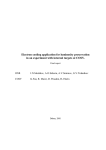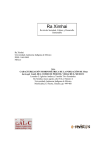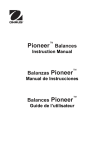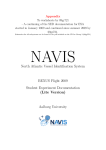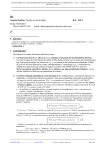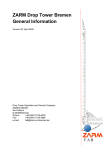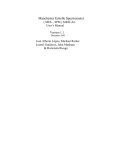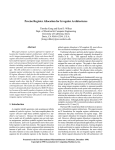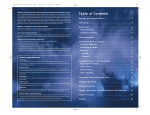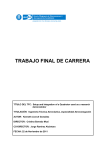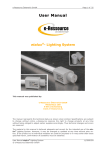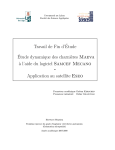Download experimental form - Universitat de les Illes Balears
Transcript
1 EXPERIMENTAL FORM The Table here below should be filled in so as to follow the changes on your experiment. For updating this document, use revision bar to show us the modification in the document. Changes table: Index (*) 0 1 2 3 4 5 6 Campaign Number 7 7 7 7 7 7 7 Revision § date n° (**) TBD All 28-2 3 28-2 4 29-2 4 29-2 5 29-2 9 29-2 12 Short description of modifications Not applicable (N/A) Provided a exactly size of the tank Clarified a few comments Added a new picture Provided more exactly sizes and weight of the rack Provided a more complete hazard analysis Update the outreach section (*) : . the index indicates the issue number of the experimental form. (**) : the number of modified paragraphs should be indicated. Team Number : 1017 2 1 – Title of the experiment and Team name Title of the experiment: Visualization of Richtmyer-Meshkov instability in liquids at zero-g. Team name : RM-0g Team Number : 1017 2 – Experiment objectives The objective of this experiment is to visualize the Richtmyer-Meshkov instability (RMi) of incompressible fluids in microgravity. The microgravity environment of the parabolic flight allows a unique opportunity to analyse the complete instability process from the early linear stages to the final transition to turbulence. RMi is produced when two separate fluids of different densities are impulsively accelerated in the direction normal to the interface between the two fluids. It is one of the most fundamental of fluid instabilities and exhibits many of the non-linear complexities that transform simple initial conditions into a complex turbulent flow. It is closely related to Rayleigh-Taylor instability, which develops when a planar interface undergoes constant acceleration, such as caused by the delay of a heavy fluid over a lighter one in the Earth’s gravitational field. This instability is important in various fields such as astrophysics [1], high speed combustions [2] and in inertial confinement fusion (ICF) [3]. In the first case, RMi is believed to occur in supernovas where the collapsing core of a dying star generates an outward propagating shock wave, which passes through the helium-hydrogen interface. In the second case, the instability is observed in supersonic combustion ramjets engines. Finally, in ICF, a high-energy laser beam is used to compress a spherical shell encapsulating a deuterium-tritium fuel mixture. In this case, RMi appears in the density interface of the fuel mixture, and the resulting turbulent flux limits the degree of compression achievable in the process. RMi experiments have originally been carried out in shock tubes using gases [4], but the major difficulty in these experiments is in maintaining a well controlled sharp boundary between two gases. The use of liquids minimizes the problems with generating a sharp well defined interface due to the low diffusion coefficients of liquids. In addition, the instability in liquids develops at considerably lower speed, thus greatly simplifying flow visualization. However, the Earth’s gravitational influence becomes increasingly important as instability growth rates decrease, so such experiments must be carried out in a low gravity environment. The effects of gravity may be minimized by keeping the fluids in free-fall while the instability develops [5]. However, the run times achievable with this method are strongly limited, even using the tallest Drop Towers currently available, and the complete transition into turbulence has not been yet satisfactorily visualized. The microgravity environment of the parabolic flight will allow a considerable increment of the run times achievable on Earth and will give a unique opportunity to take different measurements of relaxed time in microgravity of RMi and to visualize the complete instability process, from the initial linear stages, through the non-linear regime and into the final transition to turbulence. [1] Arnett, W.D., Bachall, J.N., Kirshner, R.P., and Woosley, S.E., “Supernova 1987A,” Annu. Rev. Astron. Astrophys. (1989), vol. 27, pp. 629-700 [2] Markstein, G.H., “A shock tube study of flame front-pressure wave interaction,” Sixth Symp. (Int) on Combustion, Reinhold, 387-398 (1957) [3] Lindl, J.D., McCrory, R.L., and Campbell, E.M., “Progress Toward Ignition and Burn Propagation in Inertial Confinement Fusion,” Physics Today, 45 (9), 32-50 (1992) [4] Brouillette, M., and Sturtevant, B. “Experiments on the Richtmyer-Meshkov instability: single scale perturbations on a continuous interface,” J. Fluid Mech. (1994), vol. 263, pp. 271-292 [5] Niederhaus, C. E., and Jacobs, J. W., “Experimental study of the Richtmyer-Meshkov instability of incompressible fluids,” J. Fluid Mech. (2003) vol. 485, pp. 243-277 3 3 – Experiment description The experimental set-up consists of a Lexan tank (35 cm x 20 cm x 5 cm) containing two immiscible liquids of slightly different densities, mounted to a linear rail system oriented so that the tank is free to move in the vertical direction, with approximately 1.6 m of net translation length (Fig. 1). Rails system Tank with two liquids Tank oscillating system Video camera Sled (Fig. 1) Experimental set-up A moment before the conditions of microgravity, a controlled tiny horizontal oscillation produced by a simple mechanical system with an electric motor is imparted to the tank to produce a wavy initial fluid interface shape. The tank is then released from an initial height and allowed to fall freely along the rail until it reaches the bottom, where a braking system is located to impart the impulsive acceleration needed to produce the instability. At the moment of the impact, the airplane must already be in the zero-g parabolic trajectory. Therefore, the instant at which the tank must be released should be carefully synchronized with the moment at which microgravity is produced. After the impact, the tank is stationary at the bottom of the rail and the sinusoidal perturbations initially generated oscillating the tank shall grow, the RMi instability develop and then evolve to the final turbulent regime. At non-zero gravity conditions the heavier fluid will settle underneath the lighter one, so the initial conditions are recovered. An accelerometer will continuously record both, the low gravity conditions during the instability generation and also the initial impulsive acceleration causing the instability. A camera coupled to the tank is used for video registration and an appropriate colorant is dissolved in one of the liquids, allowing a suitable visualization. Despite expected influence of the surface tension, two immiscible fluids are used to be able to repeat the experiment several times, at different parabolic trajectories, with distinct initial sinusoidal perturbations at the interface. Nevertheless, we are also interested in studying the influence of surface tension in RMi. An analogous experiment has already been built and used to monitor the RMi instability in liquids on earth at the University of Arizona [5]. The set-up has been here conveniently modified to overcome the disadvantages and get profit of the advantages provided by the parabolic flights conditions. The major advantage yields in the fact that the visualization time is going to be much larger than any previously obtained on earth, which will allow the instability to evolve up to the final turbulence steps. 4 4 – Technical description of the experiment set-up The technical set-up for the experiments consist at the moment of 7 elements mounted on a single rack, which in turn is mounted on the attachment rails. Here is an approximate list of the parts of the experiment and the materials and equipment that will probably be used to build them: - The two rail system: Two aluminium bars of about 1750 mm length will be used. - The sled: The sled will be an L-shaped support with appropriate attachments to be coupled to the rails and another horizontal rail to fix the tank, permitting it’s horizontal oscillation. It will also include a support for the camera. A strengthened aluminium will probably be used for the sled base. - A tank of net dimensions (35 cm x 20 cm x 5 cm): It will be constructed using Lexan sheets for the walls, attached together with an appropriate adherent. The thickness of the walls will be about ~5 mm. However, the bottom wall shall be slightly thicker than the others to strengthen the tank for the braking shock. - The horizontal oscillation system: Will consist of a simple mechanical gear system activated by an electrical motor. The motor will be directly attached to a small gear, which will in turn be coupled to a bigger gear with one end of a lever fixed at it’s circumference. The other end of the lever will be fastened to the tank. With this simple mechanical set-up a constant angular velocity imparted by the motor can be converted to a perfect sinusoidal oscillation of the tank. - Braking system: Different ways of imparting the braking shock are being designed and studied. A stretching of the aluminium rails at the bottom is one possibility. Another method is to place an appropriate type of deformable material, such as plastering or a rubber, at the bottom of the rails to rapidly dissipate the kinetic energy of the sled once it reaches the bottom. At this moment the team is working in the second option. - A video camera: A digital video camera will be used for a reliable registration. - An accelerometer: The accelerometer provided by Novespace, in case it’s available, will be attached to the sled. The approach for designing the experiment is as follows: The first point is designing and constructing the experimental apparatus. First, a tank has to be designed and built. As mentioned, Lexan seems the best choice for the material opposite Plexiglas. The walls of the tank have to be cut from factory Lexan sheets of an adequate thickness (~5 mm). The tank has to be perfectly hermetic, double contained and resistant to the impacts that will be imparted to it. On the other hand, the rails and the sled have to be designed and assembled. The dimensions of these parts will be approximately the ones mentioned above, but we reserve the possibility of modifying them slightly in case we find it necessary. Apart from this, the designs of the horizontal oscillation system and the braking system have to be worked out and then mounted. At last, all the parts have to be assembled and mechanically tested. The second point is to decide the exact fluids to be used. Obviously they will be immiscible and although the surface tension will play an important role in the development of the instability, it will be interesting to study this role in the RMi. Finally, the whole system, including the liquids in the tank, will be tested in the lab on-earth to detect possible malfunctions and to study the achievable braking shock accelerations. Inside the rack the experiment will be like this: 5 ~35 cm ~175 cm 20 cm 5 cm ~60 cm ~60 cm 6 5 – Installation of the experiment in the aircraft The overall dimensions for this experiment are 1m x 0.65m x 1.75m. It will take up the space of one rack and the weight should be about 45 kg (rack included). Using Plexiglas, the weight was about 30 kg, but using Lexan the weight will be a little bit heavier. However, some values can vary after building the experiment. Tank with two liquids Rack top down view Tank oscillating system 100.6 cm Aircraft rails Video Camera ~65 cm 6 –Electrical The power needed supplies just the video camera, and 220V-AC will be needed for this use. The motor needed to make the small oscillations at the tank will most probably have an internal power source. If not, the total electrical power needed for the video camera and the motor will be about 30-45 w. The electrical power give here are the expected maximum value. Confirm that the whole electrical circuits is fitted with one, and only one, emergency switch-off button (5 cm red pushbutton on yellow box, installed in a such a way to be easily accessible by the safety team) disconnecting all electrical equipment and 220V-AC and 28 V-DC power supply coming from aircraft electrical panel: Yes Confirm that the whole electrical circuit is protected by a fast fuse, adjusted to the experiment electrical consumption (8 A max for 220V-AC and 20 A max for 28 V-DC) : Yes Fuse value(s) : ………A Confirm that the whole electrical circuit is protected by ground fault interrupter adjusted at 30mA : Yes 7 – Mechanical resistance of the experiment The experiment will be mounted inside a standard rack attachment boltholes as show in NOVESPACE´s user manual. There are just one moving part, the tank with the liquids, but it will be contained inside the rack and it can not cause any injuries. 7 8 – In flight procedures and In flight personnel The experiment will be conducted as follows: after take-off, the members will check the rack. During flight (1-g), the members can be at stand-by, but seconds after the first parabola, with the acceleration of 1.8-g, the two experimenters have to be synchronized to release the sled before the microgravity environment. Once microgravity conditions are initialised, the experiment will operate on its own and the instability visualized will be recorded in a video camera. During the parabola it will not need any manipulation by the team members and when the gravity is restored the experiment shall return to the initial conditions due to the fluids properties. At last, at 1-g, the team restores the sled until the initial height waiting for the next parabola. This experiment can be repeated as many times as parabolic manoeuvres performed by the airplane. Flight Phase After take-off 1g Before first parabola 1.8 g Seconds before 0g 0g 1.8 g 1g After the last parabola Experimenter 1 Checks the rack Stand-by Checks the equipment Prepares to take the measurement Checks the video camera Visualization of the RMi Checks the video tape Stand-by Switches the systems off Experimenter 2 Checks the rack Stand-by Checks the fixation holes Prepares to release the sled Release the sled Checks the sled Release the sled to the initial height Stand-by Shuts down the experiment 9 – Hazard analysis Are there any "dangerous" products (toxic _when swallowed, breathed, eye contact.._ inflammable, infectious, radioactive, corrosive, magnetic, organic…)? No Are there any pressure systems? No What could happen in case of a sudden depressurisation (containers destroyed, etc..) ? a normal decompression (1000 to 700 mbars)? Nothing Is there any laser? Which class? Is the laser path completely and securely contained ? No Are there any motors, high electric currents or hot parts near liquid containers ? Yes, but it can not cause any injury Confirm that none electrical wire or contact is not shielded and that wire section is convenient with electrical current uses: Yes Could there be any electrostatic discharge? No What happens in case of sudden electrical power loss ? Does the experiment configure itself in safe idle mode? The experiment shut off. Are there any electro-magnetic fields generated? No Any hot part ? What is the maximum external temperature? internal temperature? Are there temperature limiting devices? Are the lights cold (if any)? Is the light glass contained? The experiment works at the room temperature Can you easily access key security items, like push button or pressure vessels tap? Yes Is it sure that no product, smoke, dust, particles can come from the experiment to the aircraft cabin (the vent line is made for this)? Yes Is the experiment very noisy, or produce any smell? No Is there any moving part ? Is the moving part reachable? Can it create injuries? Yes, but the moving part is inside the rack and can not cause any injuries Is there any human subject for the experiment? No Is the experiment working with a pump filled with oil ? How is the oil leak risk prevented ? No Is there any device consuming a lot of electrical current when activated/started ? (vacuum pump, high energy lamp,…) ? How is the start up current limited? No. Unknown 8 Hazard list 1. Liquids escaping the tank • Description of hazard The experiment contains liquids inside a protected tank. The liquids could escape. • Hazard causes Tank fracture during the free fall. • Hazard controls The liquids will not be toxic and the quantity will be minimum to be a hazard. The tank will be made of Lexan, will be double contained and will be attached with professional glue. It will be mounted and tested on a Earth-lab for pressure and impact resistance. The sheet will be 5 mm, however all the equipment will be mounted inside a rack. 10 – Pressure vessel certification (if applicable) Not applicable yet. 11 – Vent line connection and other requests Do you need to use the aircraft vent line (throwing experiments wastes out of aircraft) ? : No 9 12 – Outreach Programme In this section, the following activities before flight are considered: • A web page of the RMi project is under construction and is at the following address: http://www.uib.es/depart/dfs/esa This page include information about ESA and the parabolic flight campaign (PFC), the development of the project and will also include pictures or videos of the team and equipment. • A summary about the RMi project and the PFC is published at the number of February in the most important magazine in Spain about astronomy and astrophysics: “Tribuna de astronomia y Universo”. • A summary about the RMi project and the PFC is at the university electronic magazine “ENLLAÇ campus UIB” at the following address: http://www.campusuib.com/php/seccion.php?nrevista=5&seccion=Estudiants#442 • A summary about the RMi project and the PFC will be published whether we are short listed or not at the university magazine “ENLLAÇ UIB”. • A journalist will cover the development of the project. • A member of the team, Victor Huarcaya, is writing a diary about the PFC´s experience and the project. This diary is available in the web page. • Presentation of the RMi project and the PFC in the science festival at the UIB (aprox. April 2004) and informal lectures in our old respective schools. The collaboration with the press department of our university, “Servei de Comunicació”, with Macamen Colom as chief of this department will make a diffusion about the project and the PFC at the national and local media. This might also include: • Press releases in the following newspapers: Diario de Mallorca, El Mundo, Última Hora and Baleares. • An interviews in the following TV’s channels: TVE and Antena 3. • An interviews in the national and local radio. • A rigorous article in the magazine “Tribuna de astronomía y Universo” about the RMi and the experience to participate in the ESA´s PFC. We are waiting for the confirmation to write this article for spring of next year. We will also give an informal lecture in our university before the campaign in which we will describe the project and the PFC. We want to motivate other students to attend the PFC and other ESA´s educational activities like Physics on Stage, SSETI, Space Medicine Workshop, FOTON, YES2 space mail and IAF. However, our primary challenge is encourage the youth students in the schools to learn and study sciences. 10 13 – Team members and contacts: Team member 1 : First Name Victor Last Name Huarcaya Azañon Team member 2 : First Name Last Name Nico Piro Team member 3 : First Name Last Name Maria Tous Team member 4 : First Name Last Name Carles Bona University UIB-Universitat de les Illes Balears Phone n° +34 971206317 Cellular +34 651905839 Mail [email protected] University UIB-Universitat de les Illes Balears Phone n° +34 971285308 Cellular +34 667557690 Mail [email protected] University UIB-Universitat de les Illes Balears Phone n° +34 971287941 Cellular +34 654987224 Mail [email protected] University UIB-Universitat de les Illes Balears Phone n° +34 971615431 Cellular +34 677690277 Mail carles.bona@telefonic a.net Endorsing Professor : Sebastian Monserrat Experiment location (town and country) : UIB. Majorca-Spain. Name of team member for ESA contact : Victor Huarcaya Azañon Name of team member for Novespace contact : Victor Huarcaya Azañon Indicates flight week preferences, if any :










